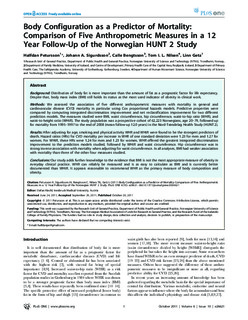| dc.contributor.author | Petursson, Halfdan | |
| dc.contributor.author | Sigurdsson, Johann A | |
| dc.contributor.author | Bengtsson, Calle | |
| dc.contributor.author | Nilsen, Tom Ivar Lund | |
| dc.contributor.author | Getz, Linn | |
| dc.date.accessioned | 2015-10-30T11:12:15Z | |
| dc.date.accessioned | 2016-03-08T14:45:05Z | |
| dc.date.available | 2015-10-30T11:12:15Z | |
| dc.date.available | 2016-03-08T14:45:05Z | |
| dc.date.issued | 2011 | |
| dc.identifier.citation | PLoS ONE 2011, 6(10) | nb_NO |
| dc.identifier.issn | 1932-6203 | |
| dc.identifier.uri | http://hdl.handle.net/11250/2381823 | |
| dc.description.abstract | Background: Distribution of body fat is more important than the amount of fat as a prognostic factor for life expectancy. Despite that, body mass index (BMI) still holds its status as the most used indicator of obesity in clinical work.
Methods: We assessed the association of five different anthropometric measures with mortality in general and cardiovascular disease (CVD) mortality in particular using Cox proportional hazards models. Predictive properties were compared by computing integrated discrimination improvement and net reclassification improvement for two different prediction models. The measures studied were BMI, waist circumference, hip circumference, waist-to-hip ratio (WHR), and waist-to-height ratio (WHtR). The study population was a prospective cohort of 62,223 Norwegians, age 20–79, followed up for mortality from 1995–1997 to the end of 2008 (mean follow-up 12.0 years) in the Nord-Trøndelag Health Study (HUNT 2).
Results: After adjusting for age, smoking and physical activity WHR and WHtR were found to be the strongest predictors of death. Hazard ratios (HRs) for CVD mortality per increase in WHR of one standard deviation were 1.23 for men and 1.27 for women. For WHtR, these HRs were 1.24 for men and 1.23 for women. WHR offered the greatest integrated discrimination improvement to the prediction models studied, followed by WHtR and waist circumference. Hip circumference was in strong inverse association with mortality when adjusting for waist circumference. In all analyses, BMI had weaker association with mortality than three of the other four measures studied.
Conclusions: Our study adds further knowledge to the evidence that BMI is not the most appropriate measure of obesity in everyday clinical practice. WHR can reliably be measured and is as easy to calculate as BMI and is currently better documented than WHtR. It appears reasonable to recommend WHR as the primary measure of body composition and obesity. | nb_NO |
| dc.language.iso | eng | nb_NO |
| dc.publisher | Public Library of Science | nb_NO |
| dc.title | Body configuration as a predictor of mortality: Comparison of five anthropometric measures in a 12 year follow-up of the Norwegian HUNT 2 study | nb_NO |
| dc.type | Peer reviewed | nb_NO |
| dc.type | Journal article | |
| dc.date.updated | 2015-10-30T11:12:15Z | |
| dc.description.version | publishedVersion | |
| dc.source.volume | 6 | nb_NO |
| dc.source.journal | PLoS ONE | nb_NO |
| dc.source.issue | 10 | nb_NO |
| dc.identifier.doi | 10.1371/journal.pone.0026621 | |
| dc.identifier.cristin | 847489 | |
| dc.description.localcode | © 2011 Petursson et al. This is an open-access article distributed under the terms of the Creative Commons Attribution License, which permits unrestricted use, distribution, and reproduction in any medium, provided the original author and source are credited. | nb_NO |
